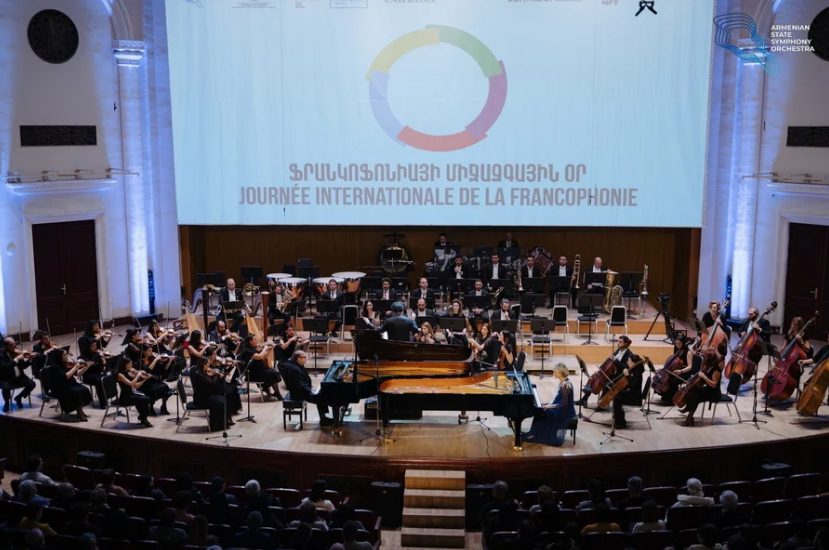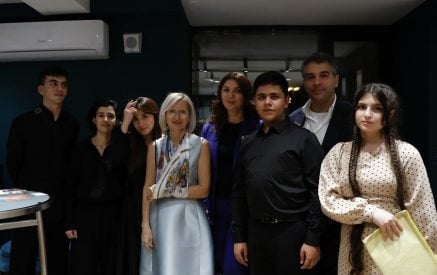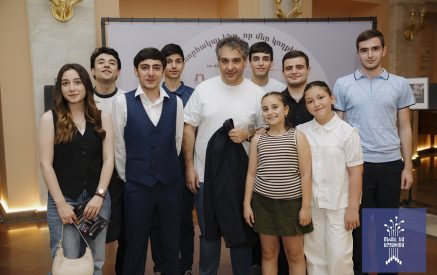This extraordinary concert by the Armenian State Symphony Orchestra, held at the Aram Khachaturian Concert Hall under the baton of Artistic Director and Principal Conductor Sergey Smbatyan, was dedicated to the significant occasion of the Francophonie Day. The evening exclusively featured French music, with masterful works by Maurice Ravel, Francis Poulenc, and Claude Debussy. The audience indeed was a distinguished assembly; embassy representatives, renowed guests of the capital city of Yerevan, and members of the public. The atmosphere in the hall was celebratory. During the concert, the orchestra showcased its exceptional ensemble mastery, delivering a performance marked by structural clarity, brilliance of the string and brass instruments, and an ability to immerse the audience into an emotionally charged musical experience.
The lightness and completeness of its harmonies made Ravel’s early piece, “Pavane for a Dead Princess,” an immediate favorite with the audience. The orchestra’s performance was both poetic and captivating. While the “Pavane” reflected the influences of Chabrier, Fauré, and Debussy, it also showcased the distinct and emerging style of a young Ravel, who was already beginning to reveal his unique artistic voice. Smbatyan’s conducting style was characterized by simplicity, composure, and clear leadership, emphasizing his temperament.
The performance of Francis Poulenc’s Concerto for Two Pianos and Orchestra was marked by great enthusiasm and a high level of artistry, featuring renowned pianists Louis Lortie and Hélène Mercier Arnault. This wasn’t the composer’s first work involving two pianists. Back in 1918, he had composed a piano sonata for four hands, but the idea of a composition with an orchestra had been brewing. The composer was captivated by this concept, and it took him less than three months to complete it.
The concerto for two pianos premiered in Venice in 1932, with the composer himself performing alongside pianist Jacques Fevre, to whom the work was dedicated. This concerto demands not only virtuosic technique from the performers but also exceptional ensemble skills, as the piano duet is nearly uninterrupted throughout the entire concert. The audience witnessed a magnificent duet. While initial interest may have been drawn to the biographical aspects of the performers, after the concerto, focus shifted entirely to the musical realm.
Read also
The seamless unity and mutual understanding between the artists were immediately noticeable, drawing attention to their polished strokes, nuanced expressions, dynamic range, and a cohesive sense of style and drama. The remarkable professionalism, impeccable taste, and clarity of performance by Hélène Mercier Arnaud and Louis Lorti gradually shifted my focus from technical excellence to more nuanced aspects. Perhaps the most valuable quality of this duet lies in their fresh interpretation – a youthful perspective on the music, characterized by a distinctive sound without sacrificing tempo or rhythm. From the very first moment, these artists are immersed in the music, feeling each musical phrase. They skillfully translate this spiritual intensity and emotional depth into the concert hall, captivating the audience with their pursuit of harmony, which embodies the essence of artistic creation. The musicians showcased not only exceptional technique but also a profound, intelligent, and delicate interpretation of the composition.
The pleasure derived from witnessing such a thoughtful performance is beyond words, and their sound quality was truly exceptional. The orchestra appeared as a single, powerful instrument with a wide range of capabilities. Every note was refined, every element shone and sparkled. The performance was astonishing in its purity, richness of tones, and vibrant colors. It was truly inspiring and infectious, reminiscent of the energy and enthusiasm of youth. The audience was captivated by the remarkable performance of pianists Hélène Mercier Arnault and Louis Lortie, which added a special touch to the event. Their music was characterized by virtuosic skill, artistic excellence, and rare expressiveness. The duo’s artistry exuded vital energy, an inexhaustible array of colors, and a controlled emotional restraint. Their names will be remembered for a long time due to this memorable concert, and they are eagerly anticipated on the world’s most prestigious stages. It is important to highlight that Hélène Mercier regularly collaborates with various orchestras and renowned musicians across Europe and North America. She has shared the stage with violinists like Salvatore Accardo, Renaud Capuçon, Ivry Gitlis, and Laurent Korcia, as well as cellists Natalia Gutman, Gautier Capuçon, Henri Demarquette, and Truls Mørk. Her duet performances with Boris Berezovsky, Frank Braley, Brigitte Engerer, Cyprien Katsaris, and Louis Lortie are notable.
She has also had solo performances alongside cellist Mstislav Rostropovich in Copenhagen and Paris. Hélène Mercier and Louis Lortie have collaborated on several acclaimed recordings featuring works by Ravel, Schubert, Mozart, Poulenc, Rachmaninoff, Saint-Saëns, and Vaughan Williams. These recordings received high praise from critics and were honored with the Diapason d’Or award. Additionally, she has released a CD dedicated to the compositions of Ernest Chausson in collaboration with violinist Vladimir Spivakov under the Capriccio label. Hélène Mercier stands out as a passionate advocate for French music and can be rightly considered an ambassador of French musical heritage on the international stage. After the concert, Hélène Mercier mentioned her past collaborations with different orchestras and expressed her delight at performing with the Armenian State Symphony Orchestra, particularly under the direction of such a bright and dynamic conductor.
The pianist remarked that under the conductor’s leadership, the orchestra has the potential to experience rapid growth. Louis Lortie, a renowned Canadian pianist and laureate of the Busoni International Piano Competition, boasts an impressive array of musical accolades. His notable achievements include acclaimed concert performances and recordings of all of Ravel’s piano works, Liszt’s entire piano and orchestra repertoire, as well as Beethoven’s extensive works (including all 32 sonatas and the sonatas for violin and piano with James Ehnes). Lortie has contributed over 45 recordings to the Chandos label, featuring a wide range of composers from Mozart to Stravinsky.
The second part of the concert was equally engaging, featuring the orchestra conducted by Sergey Smbatyan in a performance of two masterpieces by Claude Debussy, one of the giants of French and world music— the three symphonic sketches “Prelude to the Afternoon of a Faun” and “La Mer” (The Sea). Debussy’s symphonic prelude “Prelude to the Afternoon of a Faun” stands as his inaugural symphonic composition, perfectly embodying his unique impressionistic style. Created during the composer’s most luminous period from 1892 to 1894, the prelude exudes a delicate yet melancholic poetic essence, evoking feelings of admiration. It serves as a musical manifesto of impressionism, drawing inspiration from Stephane Mallarmé’s eclogue of the same title, a cornerstone of French symbolism. The prelude unfolds like a series of landscapes, each one revealing the desires and dreams of the faun drifting through the heat of the day. The orchestra delivered it with depth and subtlety, characteristics typical of the composer. The enchanting flute solo instantly transported listeners into the piece’s distinct world. Sensual melodies emerge from the brass instruments through expressive improvisation. The harp’s glissando and the interplay between brass players, which are the only brass instruments featured in the prelude, add a unique dimension to the music.
The orchestra’s rendition of the symphonic prelude “Prelude to the Afternoon of a Faun” brought a sense of lightness, freshness, and youthful inspiration to the performance, evoking feelings of romantic freedom. The musicians delivered an astonishing performance characterized by remarkable lightness, rich nuances, vibrant colors, precise execution, and delicate strokes. The concert concluded with the performance of “La Mer” (The Sea), the grandest of Debussy’s orchestral compositions. This work immerses listeners in symphonic landscapes, characterized by a rich and delicate palette of sound colors. The piece vividly captures the essence of a seascape—the tumultuous elements of water, the interplay of light, the rhythmic motion of waves, and their struggle amidst a storm.
Through the orchestra’s magnificent and graceful interpretation, one can sense the unique atmosphere of open skies, the dramatic intensity of a storm, the resounding roar of waves bathed in light, and the lively yet transparent portrayal of the sea. Simultaneously, “The Sea” encapsulates the complex and contradictory nature of human emotions.
The orchestra, under the direction of Artistic Director and Principal Conductor Sergey Smbatyan, skillfully captured the grand scale, luminosity, and richness of colors within the piece. Their performance was warm, delicate, and free of unexpected surprises. It was evident that they approached the score with great interest, delving into its secrets. The music appeared to emerge from improvisational imagery, in a burst of inspiration, capturing the essence of true magic.
Natalya Gomtsian




























































